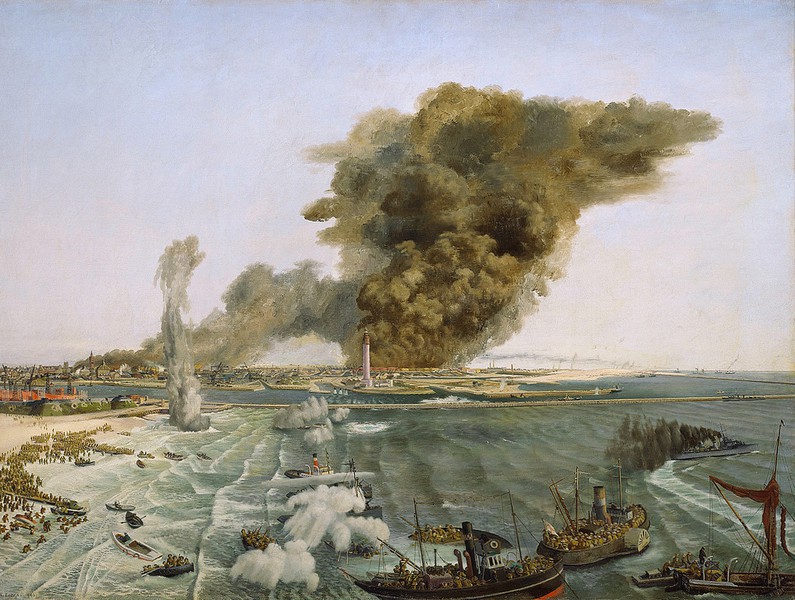

1940
Oil on canvas
76.2 x 101.6 cm
National Maritime Museum, Greenwich, London
Birds Eye View Bonfires | Flames | Smoke All Works in Public Collections Commissioned Works Official War Artist Figures on a Beach Seascapes | Coastal Scenes Ships | Boats | Harbours | Ports Towns | Town Life | Buildings Wartime Richard Eurich (1903-1992) Visionary Artist The Art of Richard Eurich
Recto: Signed lower left: R EURICH. 1940.
Aka: Withdrawal from Dunkirk [Bradford; The Withdrawal from Dunkirk [IWM; and Southampton]; (Little)"Dunkirk" [RE sales diary]
Other measurements: 76.2 x 101.6 cm [NMM], 76 x 101.5
Dunkerque Dunkirk France NMM National Maritime Museum WW2 WWII World War 2 World War II aerial viewpoint army battle beach boats ships drifter explosion high viewpoint jetty lighthouses lorries lorry lorries trucks military pier sea sidewheel naval tug smoke soldiers troops war war artistWe know of five Richard Eurich works which depict the Dunkirk evacuation. See the others below.
In spring 1940, in the face of overwhelming German advance, 366,162 Allied soldiers were evacuated from Dunkirk. Eurich immediately saw the importance of the event and wrote to the War Artists Advisory Committee: ' Now the epic subject I have been waiting for has taken place. The Dunkirk episode'. An emotionally intense tribute, painstakingly based on documentary sources, the painting made the artist famous and was used by the Navy as its Christmas card for 1940.
It is a magnificent painting, full of drama and pathos. The two most salient features are the great dark anvil cloud of smoke in the far distance, and the group of pleasure boats and craft of all kinds and descriptions, including at least one of the old-fashioned paddle steamers, in the immediate foreground. The small boats are rescuing the beleagured soldiery - seen in tiny profusion still on the beach, with shells exploding all around them - with great daring but at considerable risk. Eurich's practical knowledge of Dunkirk enabled him to be especially convincing in his rendition of the …
It is a magnificent painting, full of drama and pathos. The two most salient features are the great dark anvil cloud of smoke in the far distance, and the group of pleasure boats and craft of all kinds and descriptions, including at least one of the old-fashioned paddle steamers, in the immediate foreground. The small boats are rescuing the beleagured soldiery - seen in tiny profusion still on the beach, with shells exploding all around them - with great daring but at considerable risk. Eurich's practical knowledge of Dunkirk enabled him to be especially convincing in his rendition of the layout of beach and port, and his high vantage point allowed him the necessary distance from the action to organise it with clarity and controlled dynamism.
See the note on the Art UK website linked in References below, and also the MOMA, New York references.
Britain at War was the Committee's major overseas exhibition with oils and watercolours from over thirty artists. It opened at the Museum of Modern Art, New York, in May 1941, with some 3,000 people attending on the opening day. The selection of works was aimed at undermining American neutrality. The exhibition went on to Baltimore before fourteen images, with Canadian themes, were added for showings in Ottawa, Toronto and Montreal. The exhibition was then split in two for display in Pittsburgh and London, Ontario before the entire catalogue was exhibited in San Francisco in 1942. Britain at War then toured …
Britain at War was the Committee's major overseas exhibition with oils and watercolours from over thirty artists. It opened at the Museum of Modern Art, New York, in May 1941, with some 3,000 people attending on the opening day. The selection of works was aimed at undermining American neutrality. The exhibition went on to Baltimore before fourteen images, with Canadian themes, were added for showings in Ottawa, Toronto and Montreal. The exhibition was then split in two for display in Pittsburgh and London, Ontario before the entire catalogue was exhibited in San Francisco in 1942. Britain at War then toured Central and South America in place of 111 WAAC paintings that had been lost when the ship taking them to Rio de Janeiro was sunk.
"He recalled that his most famous work was done during spare moments in 1940 - between his wartime jobs as an air raid warden and an ambulance driver in the Southampton area."
Does this page contain inaccurate or missing information that you could help us with, or do you simply want to leave a comment?
Reproduced in:
'Listener'
'Tatler' etc